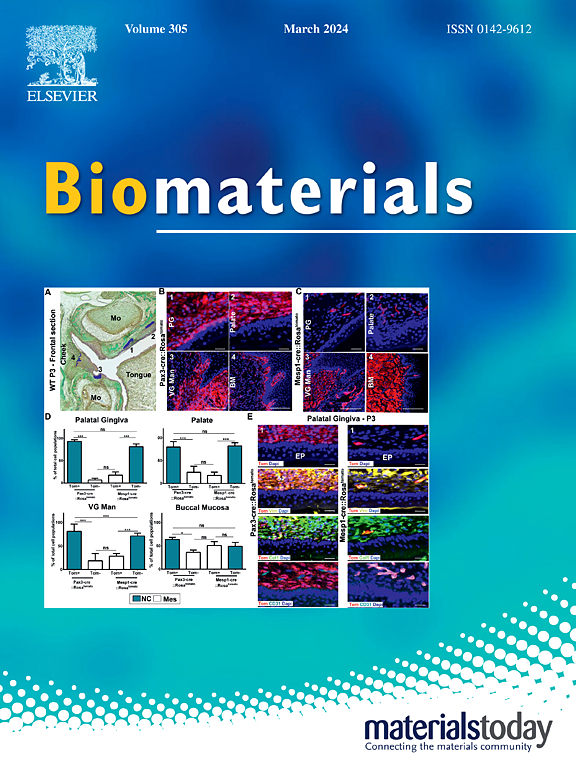Targeting the senescent surfaceome through DPP4 antibody-functionalized nanoparticles. An application to cancer therapy
IF 12.8
1区 医学
Q1 ENGINEERING, BIOMEDICAL
引用次数: 0
Abstract
Due to the heterogeneity of the senescent phenotype and the lack of a universal biomarker of senescence, the targeting of senescent cells is still an unresolved challenge, and the elimination of senescent cells using specific drugs (senolytics) is still limited in clinical use due to the off-target effects and associated toxicities of current therapeutic strategies. In this study, the induction of senescence in human melanoma cells by palbociclib is found to lead to a senescent phenotype characterized by overexpression of the membrane protein dipeptidyl peptidase 4 (DPP4), previously identified only in ageing contexts. Based on this discovery, a nanoparticle targeting DPP4 overexpression in the senescent surfaceome is designed, synthesized, and characterized to target senescent cancer cells. The nanoparticle based on mesoporous silica is loaded with the senolytic navitoclax, coated with disulfide-containing poly(ethylene glycol) to generate a redox-sensitive gatekeeper (S–S-PEG), and functionalized with an antibody against the DPP4 protein. The ability of the nanoparticles to effectively detect and eliminate senescent cells was confirmed in vitro and in vivo using a mouse model of palbociclib-induced senescent in melanoma. The DPP4-targeted nanoparticle effectively reduces tumor growth and selectively removes senescent cells. Taken together, this study highlights the potential of surfaceome-targeted nanoparticles, as a clinically relevant strategy for improving senolytic therapies.
通过DPP4抗体功能化纳米颗粒靶向衰老表面体。应用于癌症治疗
由于衰老表型的异质性和缺乏衰老的通用生物标志物,靶向衰老细胞仍然是一个未解决的挑战,并且由于当前治疗策略的脱靶效应和相关毒性,使用特定药物(抗衰老药物)消除衰老细胞在临床应用中仍然受到限制。在这项研究中,发现帕博西尼对人类黑色素瘤细胞衰老的诱导导致了一种衰老表型,其特征是膜蛋白二肽基肽酶4 (DPP4)的过度表达,这种表型以前只在衰老背景下被发现。基于这一发现,设计、合成了一种靶向衰老表面体中DPP4过表达的纳米颗粒,并对其进行了表征,以靶向衰老癌细胞。该纳米颗粒以介孔二氧化硅为基础,负载具有senolytic的navitoclax,包被含二硫的聚乙二醇(polyethylene glycol)以生成氧化还原敏感的gatekeeper (S-S-PEG),并具有针对DPP4蛋白的抗体功能化。在体外和体内使用palbociclib诱导的黑色素瘤衰老小鼠模型证实了纳米颗粒有效检测和消除衰老细胞的能力。dpp4靶向纳米颗粒有效地抑制肿瘤生长并选择性地去除衰老细胞。综上所述,本研究强调了表面体靶向纳米颗粒作为改善老年治疗的临床相关策略的潜力。
本文章由计算机程序翻译,如有差异,请以英文原文为准。
求助全文
约1分钟内获得全文
求助全文
来源期刊

Biomaterials
工程技术-材料科学:生物材料
CiteScore
26.00
自引率
2.90%
发文量
565
审稿时长
46 days
期刊介绍:
Biomaterials is an international journal covering the science and clinical application of biomaterials. A biomaterial is now defined as a substance that has been engineered to take a form which, alone or as part of a complex system, is used to direct, by control of interactions with components of living systems, the course of any therapeutic or diagnostic procedure. It is the aim of the journal to provide a peer-reviewed forum for the publication of original papers and authoritative review and opinion papers dealing with the most important issues facing the use of biomaterials in clinical practice. The scope of the journal covers the wide range of physical, biological and chemical sciences that underpin the design of biomaterials and the clinical disciplines in which they are used. These sciences include polymer synthesis and characterization, drug and gene vector design, the biology of the host response, immunology and toxicology and self assembly at the nanoscale. Clinical applications include the therapies of medical technology and regenerative medicine in all clinical disciplines, and diagnostic systems that reply on innovative contrast and sensing agents. The journal is relevant to areas such as cancer diagnosis and therapy, implantable devices, drug delivery systems, gene vectors, bionanotechnology and tissue engineering.
 求助内容:
求助内容: 应助结果提醒方式:
应助结果提醒方式:


